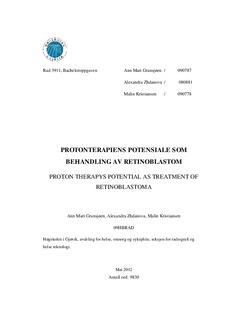| dc.contributor.author | Gransjøen, Ann Mari | |
| dc.contributor.author | Zhdanova, Alexandra | |
| dc.contributor.author | Malin, Kristiansen | |
| dc.date.accessioned | 2012-06-22T06:49:57Z | |
| dc.date.available | 2012-06-22T06:49:57Z | |
| dc.date.issued | 2012 | |
| dc.identifier.uri | http://hdl.handle.net/11250/142628 | |
| dc.description.abstract | NORSK: I denne oppgaven skal vi se på protonterapiens potensiale som cancerbehandling. Det vi kommer til å se på når det kommer til protonterapi er fysikken bak denne teknikken, nøyaktigheten den kan gi, og eventuelle fordeler / ulemper med metoden.
Formålet med denne studien er å se om protonterapi kan bli en mer optimal behandling for pasienter med retinoblastom enn de behandlingstilbudene som eksisterer i dag. Vi ser på dette som et viktig tema siden det ikke skal like mye stråledose til for å påføre senskader på barn som på voksne.
Retinoblastom er en cancertype som utgår fra netthinnen i øyet, og utelukkende rammer barn. Sykdommen kan ramme et eller begge øyne, og under fire års alder. Det finnes flere behandlingsalternativer, blant annet fotonstråling og kjemoterapi. Det vi konsentrer oss om i denne oppgaven er protonterapi, som er en form for stråleterapi. Denne bruker protoner istedenfor fotoner i sin behandling, som har en annen energikurve.
Resultatene vi kom frem til i denne studien viste at protonterapi har en helt annen nøyaktighet. Blant annet så vi sju ganger så høyere doser til orbitalbein med fotoner enn protoner. Protonterapi ser også ut til å gi mindre risiko for sekundærcancer og i noen tilfeller: mindre risiko for tilbakefall. Å konkludere med noe i denne oppgaven er vanskelig, siden det er lite tilgjengelige data om langtidseffekter av behandlingen. Det vi ser er at det kan være flere faktorer som tilsier at protonterapi kan ha et potensiale til å bli en mer optimal behandling. | no_NO |
| dc.description.abstract | ENGELSK: In this article we are going to explore proton therapy’s potential as a cancer treatment. We are going to look at the physics behind this technique, the accuracy it can offer, and any pros and cons concerning this treatment.
The objective of this study is to see whether proton therapy is a more optimal treatment option than those existing today. We view upon this as an important subject since you can induce radiation damage to a child with far less irradiation than the irradiation needed to inflict the same damage to an adult.
Retinoblastoma is a type of cancer that emanates from cells in the retina. This disease exclusively affects children, usually under the age of four, and can affect either one or both eyes. There are many treatment options, among these chemotherapy and radiotherapy. We will concentrate on proton therapy, which is a form for radiotherapy, but uses protons rather than photons which has a different energy curve.
The results we found during the work with this study were that proton therapy has quite a different accuracy than photons. We saw irradiation doses to orbital bone with photons that were sevenfold that given with protons. We also found that proton therapy seems to have a lower risk of secondary cancer and relapses. To conclude with anything in this study is difficult since there is little available data on long term effects. We can see however, that there are factors implying proton therapy’s potential to become a more optimal treatment than photons. | no_NO |
| dc.language.iso | nob | no_NO |
| dc.subject | protonterapi | no_NO |
| dc.subject | retinoblastom | no_NO |
| dc.title | Protonterapiens potensiale som behandling av retinoblastom | no_NO |
| dc.title.alternative | Proton therapys potential as treatment of retinoblastoma | no_NO |
| dc.type | Bachelor thesis | no_NO |
| dc.subject.nsi | VDP::Medical disciplines: 700::Clinical medical disciplines: 750::Radiology and diagnostic imaging: 763 | no_NO |
| dc.source.pagenumber | 43 | no_NO |
